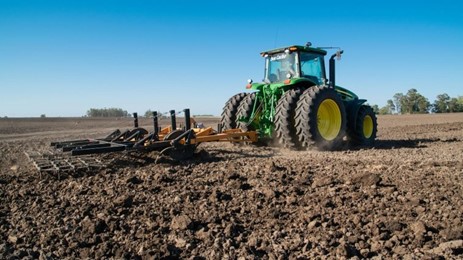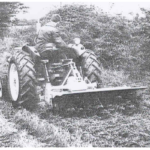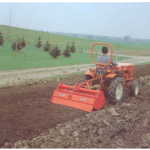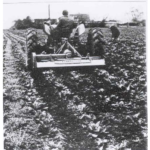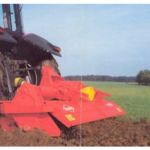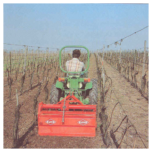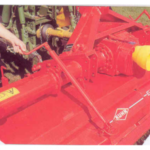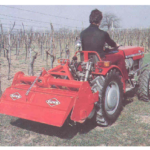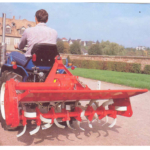The application of all rotary tillers is basically the same, and the only difference between the models is the working width.
Rotary tillers are being used to:
- shred stalks and mix them with soil (see Figure 1).
- replace the plough, disc, and harrow (see Figure 2).
- cultivate row crops (see Figure 3).
- renovate pastures (see Figure 4).
- reclaim wasteland.
- till orchards and vineyards (see Figure 5); and
- strip-till while planting.
- Figure 1: The rotary tiller shreds stalks and mixes them into the soil.
- Figure 2: The rotary tiller can replace the disc and harrow.
- Figure 3: Row crop cultivation can be done with a rotary tiller.
- Figure 4: Pastures can be renovated by using a rotary tiller.
- Figure 5: A tractor-drawn rotary tiller cultivating the soil in a vineyard.
Before using a rotary tiller, it is important to break up all compacted layers and factors that can influence root penetration. This can be done with deep cultivation implements such as rippers or other tine implements.
Several configurations have been developed over the years, but this article will discuss only the horizontal axis type, which is the most commonly used.
Rotary tillers are good for chopping and mixing trash into the soil, but they do not cover trash as completely as mouldboard ploughs. Many farmers make one pass with a rotary tiller in the beginning of summer to chop and mix maize stalks, or other crop residue, with the soil.
After large amounts of trash have been mixed into the soil, additional applications of nitrogen fertilizer are usually required to maintain fertility and speedy decomposition.
If spring weeds are a problem, the field may be rotary tilled 10 to 14 days prior to planting and weed seeds allowed to germinate. At planting time, a second pass with the rotary tiller, at a reduced depth and higher rotor speed, kills early weeds and prepares a final seedbed (see Figure 6).
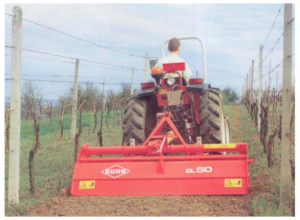
Figure 6: The rotary tiller is extremely effective for killing weeds. The working depth can be controlled to prevent damage to tree or vine roots.
To reduce operations even further, many rotary tillers can be equipped with toolbar-mounted unit planters, or a hitch for towing a planter. Tillage and planting can thus be done in one operation.
By re-arranging blade flanges on the rotor shaft, most rotary tillers may be used for strip tillage in a seedbed.
Sprayer booms may also be mounted on the tractor, or rotary cultivator, and many of these tillers are equipped with a stub power shaft on the gearbox for driving a chemical or fertilizer pump. The spray tank may be mounted on the frame of the rotary cultivator.
Plant shields, attached to the front and rear of the tiller’s frame, may be used to protect small plants from thrown soil.
Rotary tillers can be used in vineyards, citrus groves, and orchards because it is easy to control the operating depth to prevent damage to tree or vine roots. These tillers also provide a surface mulch, which conserves moisture during dry seasons in non-irrigated areas. Some rotary tillers are built for offset operations. The offset permits working under trees without injuring low branches (see Figure 7).
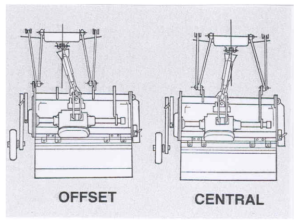
Figure 7: The offset permits the rotary tiller to work under trees without injuring low branches.
Rotary tillers can also be used in wet rice fields. The rotating blades push the tractor forward and reduce wheel slippage where it would be nearly impossible to gain sufficient traction for pulling heavy draft implements such as ploughs and disc harrows (see Figure 8). Heavy rice straw is chopped and mixed with the soil to improve fertility and soil structure. Special blades are used when working in rice fields.
Care must be taken that the rotary tiller is not used during very dry conditions, as the soil will be powdered, and the soil structure destroyed. Wear and tear will also be high under such conditions.
Although this tiller was called a rotary plough in the past, it is not a plough as far as the working depth is concerned. It can work to a depth of 200 mm, although it is not recommended to work at that depth because power requirements are then unnecessarily high, and no advantage will be obtained.
The recommended depth for rotary tillage is approximately 8 to 10 cm. At these depths there will be less wear and tear on the bearings, and the most important factor is the moisture content of the soil. If the soil moisture is correct, it is highly improbable that soil structure damage will occur, and it is advisable to use a rotary tiller at the same moisture level as with a mouldboard plough.
When rotary tilling at the correct moisture level, an average of 100 hectares can be done with one set of blades at a working width of 2 meters. Under exceptionally dry conditions, in sandy soil, 20 hectares per set of blades is not unusual.
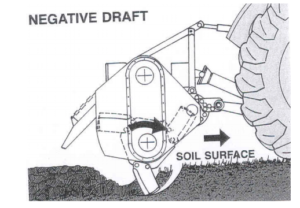
Figure 8: The rotating blades of the rotary tiller push the tractor forward and reduce wheel slippage.
It is difficult to achieve a coarse crumb texture on fine sandy soils, but with a slow rotor speed and the rear shield lifted; it is possible if the soil is moist. On soils with high clay content, the adjustments are not of primary importance and a coarse finish can nearly always be achieved.
The higher the rear shield is lifted, the coarser the finish will be. If the rear shield is lifted completely, fewer plant residues will mix with the soil and the blades will tend to place the plant residues on top of the soil. If the shield is lowered completely, most of the plant remains will be covered by soil (see Figures 9, 10 and 11).
- Figure 9: A crank handle is used to raise and lower the rear shield.
- Figure 10: A chain is used to raise and lower the rear shield.
- Figure 11: The rear shield in the raised position.
We thank the ARC Agricultural Engineering in South Africa who made the information on rotary tillers available to the readers of ProagriMedia. For more information, visit their website at www.arc.agric.za.

